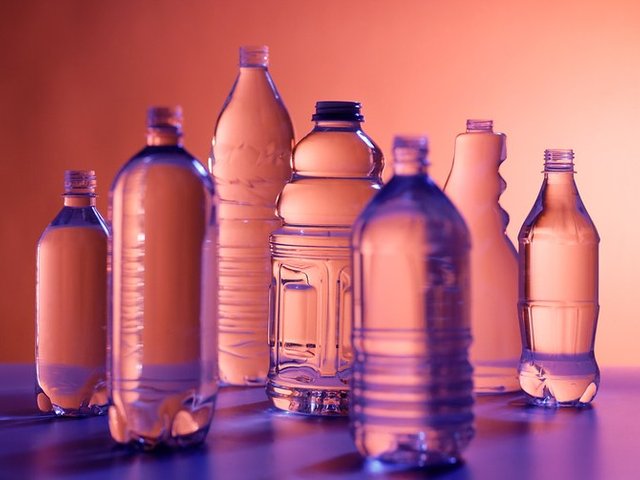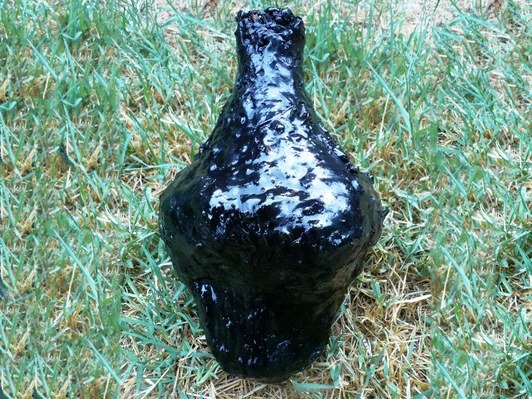Plastic Water Bottles Might Have Poisoned Ancient Californians

YOU'VE HEARD THE PSA: Recycle that plastic water bottle, or else archaeologists will be digging it up thousands of years from now. What you probably haven't heard is that archaeologists are already digging up plastic water bottles that are thousands of years old.
This not evidence of time travel. These bottles aren't clear, and they don't have labels. They're pitch black—made by indigenous tribes who coated large, woven bulbs with a tar-like substance called bitumen. Scientists have known about these bottles for years. But what they hadn't considered was whether these plastic bottles contributed to the declining health in some old societies, like the Native American tribes that once lived off the coast of California. Skeletons dating back thousands of years evidence a mysterious physical decline. A new study, published today in the journal Environmental Health, measured the toxicity of making plastic from oily bitumen, and of storing liquid in the bottles.
Modern water bottles aren't that different, really. But frozen, reused, even microwaved, there's not much risk of the liquid in them leaching enough harmful molecules—BPAs, DEHA, PET—to cause health problems. These ancient plastics are a different story, however. Bitumen is basically asphalt. Yes, basically the same stuff (when mixed with rocks, sand, and aggregates) that is used to pave roads. It's dense, viscous or semi-solid when cool, but turns into a malleable slop when heated up. It also releases chemicals known as polycyclic aromatic hydrocarbons, or PAHs, known to cause cancer (cigarettes, burning wood, and other smoky sources produce PAHs) and other health problems.
California's Channel Islands sit a few miles off the coast of Los Angeles. Like the mainland, they are dry. "They are also one of few places in North America where you find a more or less continuous population in the Americas, at least until the Industrial Age," says Sabrina Sholts, an anthropologist at the Smithsonian’s National Museum of Natural History in Washington, DC. "The earliest evidence we have of of people on these islands comes from about 13,000 years ago." One of the outstanding mysteries about these island-dwelling tribes—collectively called the Chumash—is why their overall health began to decline, beginning around 5,000 years ago.
Skeletal remains dating back to that time start to exhibit poor bone quality, reduced stature, smaller skulls, and bad teeth. Now, lots of things can cause these issues. Some researchers posit that malnutrition, poor sanitation, infectious disease, and lack of resources brought about by increased population on the islands might be the culprits. But Sholts developed a different hypothesis.
On certain beaches in Southern California, you have to watch your step to avoid stumbling on a nasty little ball of tar. Some come from the oil rigs offshore, but these balls have actually been washing ashore for thousands of years, the result of submarine seepage. This is bitumen, and for thousands of years Native Americans in this region had used it to build boats, make weapons, and craft water bottles. Sholts went to graduate school at UC Santa Barbara, and she recalls that one of her colleagues working with bitumen advised her early on to wear gloves and a mask to handle the stuff. She had recently learned about how Native Americans in this region had stored water in bitumen bottles. "I became uncomfortably curious, and not sure how strongly I should consider this as a factor in some of the changes I had seen in the skeletal record," she says.
After getting her PhD and a job at the Smithsonian, she took the opportunity to explore that curiosity. She conscripted a colleague, Kevin Smith, to recreate the bottle-making process. Smith is an archaeologist at UC Davis who has permits to do work on the Channel Islands—much of which are protected.
To make a Chumash-style plastic bottle, you start by weaving a bottle-shaped basket. Then you combine bitumen and pine pitch in an abalone shell. You have to melt them together, but you don't place the abalone directly onto the fire. Instead, you roast some pebbles in a fire until they are piping hot. Remove the pebbles, place them in the abalone, and stir them around until the the mixture is wet, hot, and bubbly. Finally, use a stick to paint the molten bitumen over the bottle-shaped basketry.
For scientific accuracy, Smith collected his materials from the islands—the plants for the basket, the pitch, the bitumen, even the pebbles. The only modern interlopers—besides Smith himself—were a cardboard windscreen and a mass spectrometer to measure that ominous white smoke.
Next came the environmental assessment. As everyone in this Dr. Oz-ified society knows, plastic bottles pollute whatever is put in them. So after the bottles cooled (the team made two of them, each with a different bitumen-to-pitch ratio), Smith and Sholts shipped them off to colleagues in Sweden. They filled the bottles with water, let them sit for two months, and analyzed the results. The results: accumulations of naphthalene, phenanthrene, and acenaphthalene, all of which are compounds with known toxicity.
The Chumash also likely ate food off bitumen-coated objects. So the Swedish cohort also filled the bottles with olive oil to test whether toxins would leech into lipids. (Of course, the Chumash didn't have olive oil, but it's a serviceable proxy for the fatty fish and marine mammal meat that comprised the Chumash diet.) "If you want to measure uptake directly, you need to have soft tissue," says Sholts. "We were looking to get a baseline measurement of what the fat could do."
The air sampling showed that the smoke produced while making one of these proto-plastic bottles had a much higher concentration of toxins than cigarettes. The water had very low concentrations of the toxic compounds. The olive oil took up way more PAHs, but the researchers noted that the olive oil they bought had detectable PAHs in it before they put it in the bottle.

Transporting water—in bottles, through pipes—has always been tricky business. It's not just a matter of using a material that doesn't leak. Water is the universal solvent. Given enough time, and the right pH, it will dissolve just about anything.
Sometimes this means leaching toxins from substances strong enough to contain the leaks, like the lead from Flint's pipes.
According to Sholts' study, the bitumen those Chumash islanders used to make their bottles didn't leak enough chemicals into their water to account for their skeletal problems. The ones who made the bottles did, but Sholts points out that they probably weren't making the bottles frequently enough to accumulate dangerous levels of the toxins in their bodies. However, she says this study was limited by the fact that they had to do everything by proxy—they only had Chumash skeletons to go by.
"It’s hard to say how much of any chemical exposure would induce health problems," she says. "It's dependent on dose, duration, and when in the person's life they were exposed." She says the field also needs more research on how to detect toxic organic compounds in bone. Toxicologists mostly concerned themselves with the recently dead, so much of the published research only looks at toxin uptake in soft flesh. "Bones are all I have," she says.
whoa!